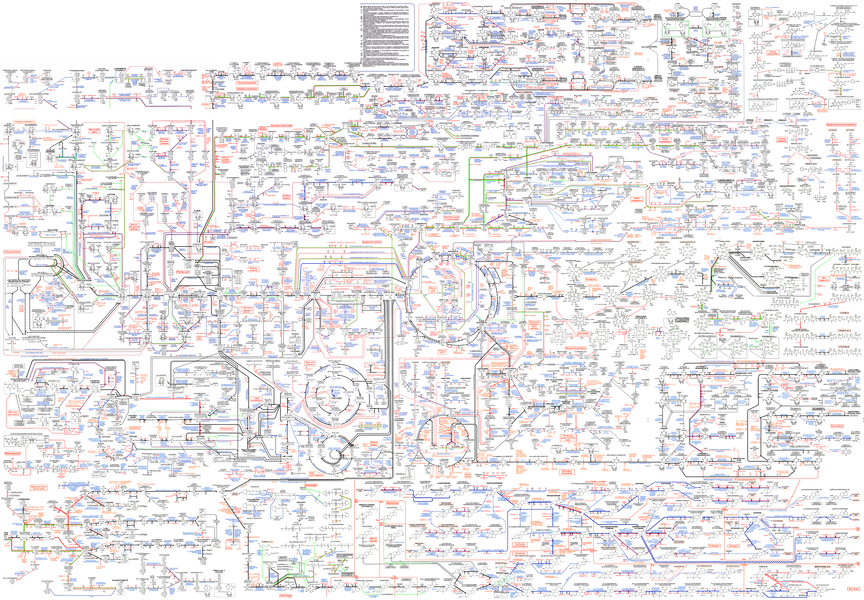Michaelis-Menten kinetics
2017-10-20
What do enzymes do to the reaction coordianate to speed up reactions?
They lower the activation energy by stabilizing the transition state
_____________ changes in activation energy lead to ____________ changes in rate.
- Small, large
- Small, Small
- Large, Small
- Large, Large
1 and 4
Stabilizing TS by $67 \ kJ \cdot mol^{-1}$ gives a 100-billion fold increase in rate!
What part of the serine protease enzymatic mechanism does the most to speed up the reaction?
Oxyanion hole: 2 hydrogen bonds to the negatively charged intermediate
How do organisms regulate the rates at which they do chemistry?
 Gerhard Michal, Roche
Gerhard Michal, Roche

Conceptual goals
- Understand the properties of Michaelis-Menten enzymes
- Understand how experimental rate measurements allow determination of MM parameters
- Understand how cells tweak these parameters to achieve regulated activity
Skill goals
- Interpret experimental graphs for MM enzymes in terms of altered MM parameters.
- Interpret changes to those parameters in terms of altered underlying chemistry.
Resources
Homework (do it...)
Lab 5
Practice problems later
Simulator http://aclarke.uoregon.edu:8000
$E \cdot S \color{red}{\rightarrow} E + P$
Expand the arrow:
$E \cdot S \color{red}{\rightleftarrows E \cdot TS \rightarrow } E + P$
$E \cdot S \color{red}{\overset{k_{cat}}{\rightarrow}} E + P$
$k_{cat}$ is the rate constant for the reaction once substrate is bound
$velocity = V = [E \cdot S] k_{cat}$
What determines $[E \cdot S]$?
- $[E]_{T}$: the total enzyme concentration
- $[S]$: the substrate concentration
- $K_{M}$: the "affinity" of the enzyme for substrate
$V = [E \cdot S] k_{cat} = [E]_{T} \theta_{ES} k_{cat}$
What is $\theta_{ES}$?
$E \cdot S \overset{K_{M}}{\rightleftarrows} [E] + [S] $
$\theta_{ES} = \frac{[ES]}{[E] + [ES]}$
$\theta_{ES} = \frac{1}{1 + K_{M}/[S]}$
$K_{M}$ (the Michaelis constant) is basically a $K_{D}$. It measures the affinity of the enzyme for substrate.
The Michaelis-Menten equation:
$V_{0} = k_{cat}[E]_{T}\frac{1}{1 + K_{M}/[S]_{0}}$
The velocity of a reaction is determined by:
- The rate constant for the enzyme when bound to substrate ($k_{cat}$)
- And the concentration of substrate bound to enzyme. This is determined by $K_{M}$, $[S]_{0}$, and $[E]_{T}$.
$E + S \color{blue}{\overset{K_{M}}{\rightleftarrows}} E \cdot S \color{red}{\overset{k_{cat}}{\rightarrow}} E + P$
Would a mutation to serine protease disrupting the oxanion hole alter $k_{cat}$ or $K_{M}$?
$k_{cat}$ would go down. It would disrupt ability to hop over transition state.
How would it alter the $V$ vs. $S$ curve?
It would lower the maximum rate, but leave shape unchanged.
$E + S \color{blue}{\overset{K_{M}}{\rightleftarrows}} E \cdot S \color{red}{\overset{k_{cat}}{\rightarrow}} E + P$
Would a mutation to serine protease disrupting binding of the peptide alter $k_{cat}$ or $K_{M}$?
$K_{M}$ would go up. It would disrupt ability to bind substrate.
How would it alter the $V$ vs. $S$ curve?
It would raise the $K_{M}$, but leave the maximum rate unchanged.
Summary I
- Enzyme chemistry can be described by:
$E + S \rightleftarrows ES \rightarrow E + P$ - Initial enzyme velocity ($V_{0}$) is:
$V_{0} = k_{cat} \times [E]_{T} \times \theta$ - $k_{cat}$ is the "intrinisic enzyme rate" in $s^{-1}$
- $[E]_{T}$ is the total enzyme concentration
- $\theta$ is the fractional saturation of the enzyme with substrate
- $\theta = \frac{[S]_{0}}{K_{M}+[S]_{0}} = \frac{1}{1 + K_{M}/[S]_{0}}$
- $K_{M} \approx K_{D}$ for substrate
Summary II
- Michaelis-Menten equation is:
$V_{0} = k_{cat} [E]_{T} \frac{[S]_{0}}{K_{M} + [S]_{0}} $ - Mucking up enzyme chemistry lowers $k_{cat}$
- Mucking up substrate binding increases $K_{M}$